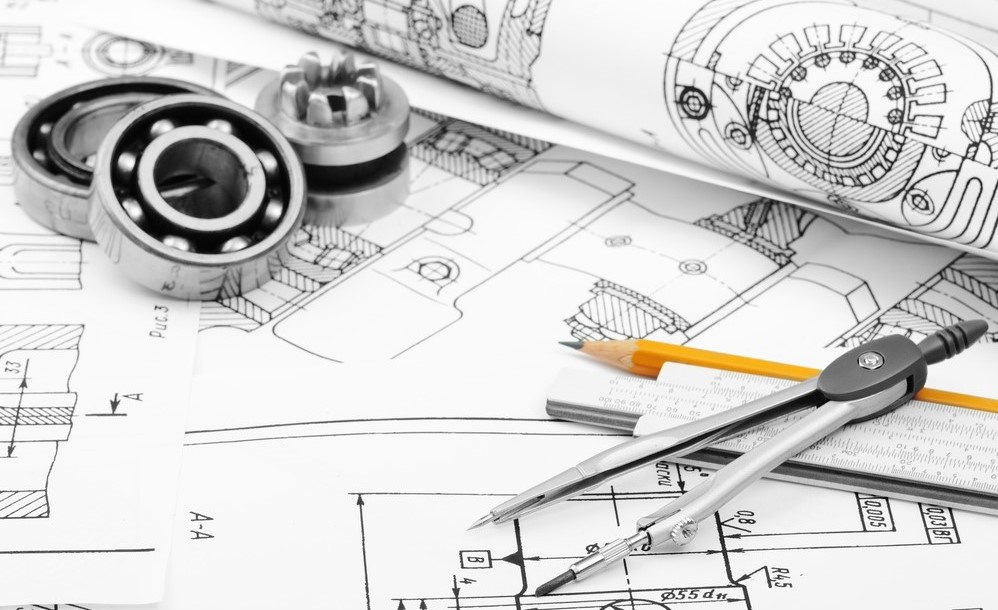Computer Aided Engineering Drawing Using Autocad
How Industries Use CAD: Engineering
Updated Jun 1, 2022

Since the introduction of CAD, design work that once used pen and paper now uses computers. CAD software replaces the traditional drawing board and makes design processes faster and smarter than ever before. CAD is a feature of every industry that produces a tangible product, from fashion to architecture. No matter what you use it for, CAD helps us explore ideas, visualize concepts, simulate designs and produce them.
In this article, we'll look at how the engineering industry and its sub-disciplines use CAD. We'll even take a quick look at examples of CAD software used in the industry.
The History of CAD and Engineering
Computer Aided Design has a rich history that spans back to over 50 years ago. When the software began to gain traction in the 1970's, it was predominantly a proprietary tool for heavy industries. By the 1980's however, commercial CAD systems began to appear in the engineering industry including the aerospace, shipbuilding and automotive sectors.
The release of parametric modelers like Pro/ENGINEER brought about an entirely new way of engineering and designing. These programs gave engineers the ability to set clear parameters, features and relationships. Parametric modelers in particular were paramount in the progress of the engineering industry. Boeing for example, made use of parametric modeler CATIA to design and draft the new 777 aircraft in 1988.
CAD, to put it simply, was revolutionary in the engineering industry. It started to merge the roles of drafters, designers and engineers. In fact, if you ask people today what the differences are between the three roles, you'll find some overlap—you can see this in AutoCAD careers.
Take a look below to see how CAD works in the engineering industry.
How CAD is Used in Engineering
Design

Computer Aided Design is used in the engineering industry to produce designs, specifications and models for mechanical components or systems. Engineers can use this software throughout the entire engineering process—from the conceptual stages to strength analysis to the manufacturing methods for components.
CAD provides the quality, accuracy and precision that is required for engineering and manufacturing. The entire production process can be sped up with CAD. Engineers no longer have to redraw blueprints or designs when they need to make modifications. Instead, they can reuse elements from previous designs and isolate, analyze and redesign individual components.
Simulations
CAD doesn't just help engineers create designs, it also gives them the ability to fully analyze their designs through simulations. Engineers can measure stress levels, simulate the flow of fluid and calculate the tolerances of their design. Essentially, they can figure out the strengths and weaknesses of their designs without having to manufacture them.
CAD software locates flaws and troubleshoots problems that engineers would otherwise only discover after production. Additionally, it can also simulate how a prototype would function in certain environments, including extreme environments which would be difficult to replicate in the real world. CAD packages make use of CAE applications to aid in engineering analysis tasks.
CAE
Over the years, CAD programs have had time to evolve to suit the needs of specific industries. CAD applications now come with rendering capabilities and other tools which are integrated modules or standalone products—CAE is an example.
Computer Aided Engineering tools are used to analyze the performance of components and assemblies. CAE encompasses simulation, validation and optimization of products and manufacturing tools. Specific tools include:
- Finite Element Analysis: stress analysis on components and assemblies.
- Computational Fluid Dynamics: thermal and fluid flow analysis.
- Multibody Dynamics: dynamic behavior of interconnected bodies.
The capabilities that engineers now possess due to CAD and CAE have resulted in most design verification being completed using computer simulations rather than through physical prototype testing. A worldwide CAD trends study conducted in 2016 found that usage in CAE is expected to grow to 43% over the next 3-5 years. The study also found that those in the manufacturing industries tend to use it most for design optimization, design validation and prediction of product performance.
Benefits of CAD to the Engineering Industry
It's easy to see why the engineering industry has embraced CAD. With CAD software, engineers have access to hundreds of incredible capabilities. Take a look at some of the benefits of using CAD software for engineers and designers across the engineering industry.
- More precision and control. Engineers can now analyze and measure each component of their projects. CAD makes the design process far more intuitive and efficient.
- Faster design execution. Before CAD, engineers would have to redraft their designs every time a flaw or error was found. As you can imagine, this would lengthen the design process. In contrast, CAD software enables engineers to make quick modifications.
- Cost efficiency. Engineers no longer have to create a physical prototype for each step of the design process. They can make changes to their CAD prototype and then take their project straight to manufacturing once it has been reviewed. Consequently, engineers can expect lower costs and shorter design completion times.
- Better documentation and collaboration. Every step of the design process can be well-documented with CAD. This prevents designs from being damaged or lost over time. Engineers can save these designs and send them to fellow engineers for collaboration, or to clients for review.
What is a CAD Engineer?
There are different levels of CAD engineers from junior to senior. The more senior roles tend to have more responsibility and complexity – and of course come with higher pay.
Junior CAD engineers will typically start with basic design tasks working on 2D drawings – commonly referred to as CAD drafting – and will work under the guidance of more senior CAD engineers. Some tasks may include re-drawing old technical drawings, converting PDFs to DXF / DWG files or changing the design of a component or part to suit a new design or manufacturing specification.
As a CAD engineer grows in experience and knowledge, they will be given more complicated tasks including 3D modelling and running simulations (e.g. finite element analysis) where a deeper understanding of not just the CAD package is required, but a wider knowledge of the engineering discipline the CAD engineer is working in.
The Main Branches and Sub-disciplines of Engineering
Engineering is a broad field that encompasses a range of more specialized disciplines and sub-disciplines. There are four main branches: chemical, electrical, civil and mechanical engineering. There are, of course, sub-disciplines that offer specialized knowledge and skills in a particular field. Automotive engineering, for example, is a sub-discipline of mechanical engineering focused more heavily on vehicle design and testing.
Here is a list of the main branches of engineering:
1. Chemical Engineering
Chemical engineers design large-scale processes that convert chemicals, raw materials and energy into a useful product. This branch of engineering involves managing plant processes and conditions to ensure optimal plant operation. Chemical engineering design concerns the creation of plans, specifications and analyses for new plants or plant modifications.
CAD programs can be used for process design and analysis—e.g. for the definition of equipment types and how they're connected together. Engineers can also use their knowledge and CAD to select optimal production methods and plant equipment to minimize costs and maximize safety and profitability.
The sub-disciplines of chemical engineering include:
- Process design: design of processes for desired physical/chemical transformation of materials.
- Chemical reaction engineering: involves optimizing chemical reactions to define the best reactor design.
- Process control: deals with architectures, mechanisms and algorithms for maintaining the output of a specific process.
- Process development: used for the design, analysis and optimization of technical processes such as chemical plants and power station.
2. Civil Engineering
Civil engineers design and construct public and private works such as infrastructure, bridges, dams and buildings. Their projects can take years and millions of dollars to build—they also have a huge impact on people's lives. It's therefore critical that these projects go well, starting right from the design phase.
3D models of terrain can be created in CAD—incorporating existing topography, geological data and utilities. They allow the engineer to design and redesign a building as many times as they need to create the perfect output. Civil engineers can use CAD to take thousands of factors into account such as the cost, the terrain and the hours required.
The sub-disciplines of civil engineering include:
- Materials science and engineering: studies the fundamental characteristics of materials—dealing with ceramics, strong metals and thermosetting polymers.
- Construction engineering: involves planning and execution, transportation of materials, environmental, structural and geotechnical engineering.
- Environmental engineering: addresses the issues of energy preservation, production asset and control of waste from human and animal activities.
- Geotechnical engineering: concerned with the engineering behavior of earth materials—they use principles of soil and rock mechanics to investigate subsurface conditions and materials.
3. Electrical Engineering
Electrical engineers design, develop and test the manufacturing of electrical equipment. CAD enables these engineers to create electrical and electronic diagrams, control circuit diagrams, schematics and documentation.
CAD typically comes with libraries of parts and symbols which allow electrical engineers to automate design tasks and generate bills of materials (BOM) reports. It's possible to create electrical schematic designs based on wire material type, temperature and maximum voltage drop. CAD certainly improves the productivity of electrical engineers as they are able to build default circuits and reuse them later.
The sub-disciplines of electrical engineering include:
- Electronics: involves the design and testing of electronic circuits that use the properties of component such as resistors to achieve a certain functionality.
- Microelectronics: deals with the design and micro-fabrication of small electronic circuit components for use in an integrated circuit or as a general electronic component.
- Telecommunications: seeks to support and enhance telecommunication systems. It involves anything from basic circuit design to strategic mass developments.
- Computers: concerned with the design of computers and computer systems. It may involve the design of PDAs, tablets, supercomputers or computers that control industrial plants.
4. Mechanical Engineering
Mechanical engineers are concerned with the improvement and modification of mechanical components and systems. They research, design, develop and test mechanical devices. Additionally, they research designs and make recommendations based on industry standards and regulations.
CAD comes in handy as engineers can design components and assemblies to fit their strict technical specifications. Some CAD programs can also automatically generate a bill of materials (BOM) for a particular design, based on a library of components. Mechanical engineers can also make use of simulation to test everything from stress to measuring vibrations in order get the perfect output without having to create and modify real-world prototypes.
The sub-disciplines of mechanical engineering include:
- Mechatronics: combination of mechanics and electronics that is concerned with integrating electrical and mechanical engineering to create hybrid systems.
- Structural analysis: concerned with the effects of physical loads on physical structures and their components.
- Mechanics: the study of forces and their effect on matter. It can involve analyzing and predicting acceleration and deformation of objects under known forces or stresses.
- Thermodynamics: deals with the study of energy, its use and transformation through a system, e.g. heat and temperature and their relation to energy and work.
CAD Software Used in the Engineering Industry
To finish off, we've put together a small list of the top CAD software used in the engineering industry. The list predominantly focuses on mechanical design and parametric modelers.
1. Fusion 360
 Fusion 360 was Autodesk's first venture into the realm of cloud-based CAD. The software is "the first 3D CAD, CAM and CAE tool of its kind". It provides parametric tools that allow designers to edit components as their specifications change. It also gives users the ability to test fit and motion, perform simulations and create photo-realistic renderings.
Fusion 360 was Autodesk's first venture into the realm of cloud-based CAD. The software is "the first 3D CAD, CAM and CAE tool of its kind". It provides parametric tools that allow designers to edit components as their specifications change. It also gives users the ability to test fit and motion, perform simulations and create photo-realistic renderings.
2. CATIA
 CATIA was developed by Dassault Systèmes and comes with CAD, CAM and CAE support. It's often referred to as a 3D PLM (Product Lifecycle Management) software suite. CATIA is widely used throughout the engineering industry, more specifically, sectors like automotive and aerospace that require rich surface modeling.
CATIA was developed by Dassault Systèmes and comes with CAD, CAM and CAE support. It's often referred to as a 3D PLM (Product Lifecycle Management) software suite. CATIA is widely used throughout the engineering industry, more specifically, sectors like automotive and aerospace that require rich surface modeling.
3. SolidWorks
 SolidWorks is a solid modeling CAD and CAE program that was also developed by Dassault Systèmes. It was the first significant 3D modeler for Windows in 1995. Engineers can use it to create auto-generated 2D drawings and advanced 3D models using a parametric feature-based approach. Users can also perform analyses and simulations including Finite Element Analysis.
SolidWorks is a solid modeling CAD and CAE program that was also developed by Dassault Systèmes. It was the first significant 3D modeler for Windows in 1995. Engineers can use it to create auto-generated 2D drawings and advanced 3D models using a parametric feature-based approach. Users can also perform analyses and simulations including Finite Element Analysis.
4. Creo Elements/Pro
 Previously known as Pro/ENGINEER, Creo was developed by PTC. It was the first major mechanical CAD software to bring parametric feature-based 3D modeling to the world of CAD. The software comes with fully integrated CAD, CAM and CAE solutions. These solutions allow users to develop everything from concept to manufacturing within one single application.
Previously known as Pro/ENGINEER, Creo was developed by PTC. It was the first major mechanical CAD software to bring parametric feature-based 3D modeling to the world of CAD. The software comes with fully integrated CAD, CAM and CAE solutions. These solutions allow users to develop everything from concept to manufacturing within one single application.
5. Autodesk Inventor
 Another of Autodesk's popular products, Inventor is a 3D CAD software that offers 3D mechanical design, documentation and product simulation tools. It enables users to produce precise 3D models to aid in designing, visualizing and simulating products before they're built. Simulation tools allow users to input factors like driving loads and friction loads to test how their product will function in a real-world scenario.
Another of Autodesk's popular products, Inventor is a 3D CAD software that offers 3D mechanical design, documentation and product simulation tools. It enables users to produce precise 3D models to aid in designing, visualizing and simulating products before they're built. Simulation tools allow users to input factors like driving loads and friction loads to test how their product will function in a real-world scenario.
Conclusion
In this article, we have covered the history of CAD and how it took off in the 1970s. We also covered the different uses of CAD in engineering and what the main branches and sub-disciplines are including chemical engineering, civil engineering, electrical engineering and mechanical engineering.
CAD engineering, and therefore the role of the CAD engineer, is varied – as you can see in our overview of what a CAD engineer does. Whether it be 2D drafting, 3D modelling, running simulations or supporting real world tests, there is a spread of CAD software that a CAD engineer uses and we cover five of the main CAD packages in the section above.
Source: https://www.scan2cad.com/blog/cad/how-engineers-use-cad/
0 Response to "Computer Aided Engineering Drawing Using Autocad"
Post a Comment